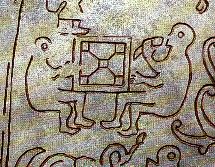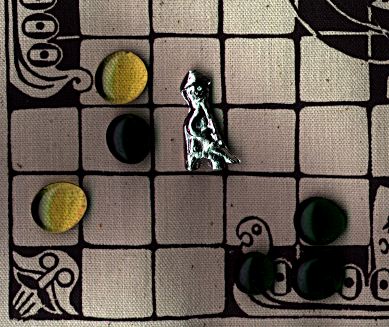

|
Both Darrell Markewitz and Neil Peterson have long experience in presenting elements of Medieval life, especially the Viking Age to school groups and the general public. Over the years, one of the most useful ways to involve people in the daily life of the Norse has proven to be the playing of the ancient game "hnefatafl" ("nev - a - tah - full"). Hnefatafl has fairly simple rules, with all pieces sharing the same movement and basic capture method. It has been taught successfully to children as young as 10 - who upon occasion have won the first game! Its simplicity is deceptive, with a combination of close "tactical" play (removing individual counters), plus a wider "strategic" objective (moving the king to the end goal). For this reason it is a game that can engage skilled players for considerable time - providing a challenge at all levels. In 1992, Darrell started work on the "Norse Encampment" - a living history program using costumed interpreters to portray aspects of daily life during the Viking Age. The presentation was a feature of the 1993 and 94 Orangeville Medieval Festival, with some 15,000 visitors over each two day run. Neil assisted as one of the interpreters in 1996, when Parks Canada mounted a two week demonstration of the program on the actual Norse site in L ' Anse aux Meadows Newfoundland. This proved such a success that in 1997, Parks Canada, along with the Viking Trail Tourism Assn, sponsored the creation of a full time interpretive program called "the Viking Encampment" for the L' Anse aux Meadows NHS. (This program continues as a daily feature at the site.) Through all phases of the programs development, hnefatafl remained a major element .
After the 1996 demonstration of the Encampment, Darrell and Neil decided that there was a clear opportunity to develop a version of hnefatafl for sale to today's general public. The only versions of the game available for sale in North America were either poorly designed - or quite expensive (in some cases both!). They had the following goals in mind for this project:  is the result!Hnefatafl translates from old Norse to the English "Kings Table". It traces is roots, through artifacts, back almost 1500 years. It has remained popular in Scandinavia right up to the present day. In modern Iceland there are still tournaments for hnefatafl "grand masters". Rules for the game were recorded in the 1700s by Linnaeus. Neil has done considerable research into the documented history of the game. (See his article on The History of Hnefatafl.) He has also experimented and play tested many variations on the basic rules and historic board layouts over the last 15 years. Darrell has over 20 years experience in artifact reproductions, and has done work for a number of major museums. A a specialist in the material culture of the Viking Age, He was the Interpretive Program Designer for the L' Anse aux Meadows HNS.  In creating the physical design for Viking Game, actual artifacts from the Norse period, from 800 - 1000 AD in Northern Europe, were used as prototypes. The image used on the game bag, the Viking Game logo, is a good example of this.  There are many references to the playing of hnefatafl recorded in the Sagas - the great adventure stories of the Viking Age. More remarkable is this image, part of a carved rune stone from Sweden. On the carving are two seated figures, one a man with a beard and a drinking horn. They have the game board between them, clearly marked with the"throne" and corner squares. This clear, strong image was an obvious choice! Originally we had decided to hold the game pieces in a cloth bag, but increasing costs have forced us to replace this with a hard cardboard tube. The new (2016) package allows the game board to roll and lay out flat - a problem with the folded method required earlier. Just at the Norse were the great voyagers of their age, the secure tube allows you to take your Viking Game anywhere!  All of the artifact sample of game boards are carved into various wooden surfaces. Many are actually cut into the back surface of flat trenchers, a style of bowl or serving dish common in the Early Middle Ages. Many are fragmentary, and there are a few that are actually specially constructed for use as game boards alone, as in the sample below. It was decided that to make Viking Game portable (and to keep the cost down), it would be better to use a printed canvas board. Of the various versions of the game used in ancient times, the 11 x 11 playing field was chosen. (More about the board graphics in a minute!)
Glass was an import item during the Viking Age, with bright colours much sought after. As with most import items, ownership of glass objects would have been signs of wealth and status. Although there are also carved antler and amber counters in Norse sites, there have been several sets of glass counters found. The bright green and yellow glass drops used for the two teams in Viking Game reflect the "best quality" counters used 1000 years ago. The king piece used for Viking Game is based on the small bronze figure of the god Thor shown above. Before the turn of the first millennium, most Norse had not yet converted to Christianity, and Thor was very much the common mans god. Small amulets in the shape of Thor's hammer are one of the most numerous artifacts from Viking Age graves. Each king piece for Viking Game is individually cast in hand cut soapstone moulds. This is the same method used by Norse metalsmiths to produce pewter jewellery for the middle class 1000 years ago! Our kings are made of modern lead free pewter, a non toxic alloy consisting of 92 % tin.
Now back to the graphics on the board itself. Several overall concepts were kicked around, and designs roughed out, in considering the layout of the playing surface. Eventually we decided to work with the whole idea of "attackers and defenders" in choosing the graphics. What is more natural for "attacking" Vikings than to have them inside those famous dragon ships? There are a large number of images of Viking ships to be found on rune and picture stones, most shown at full sail. The graphic used for Viking Game is not based on any particular historic depiction, but shares elements common to most. The ship has the typical dragon head prow and coiled tail stern post. There is a row of shields along the freeboard. Saga tales speak of striped and painted sails and ship names like "Ravens Wing".
For the "defenders", the obvious image was that of a Viking Age ring fort. The defensive structure is seen as a plan view from above. Remains of these large forts, with their circular earthwork walls, are common in Denmark. The turf long houses inside where placed in a defensive square, so that only the small gaps between the houses need be defended should the walls fail. In our image, each of the four entrances is flanked by a pair of rune stones. The central square on the board is the "throne", the starting space for the king. It is marked by a shield and crossed swords, plus the rune like makers mark that Darrell uses. On each of the corners is the special "kings corner" - the space that the king needs to reach to win the game.Remember how this space is marked on both the wooden board from Ireland and the image on the rune stone? In stead of just an X, we chose to use this image of a Norseman with his fierce moustache. It is a detail from an artifact found at Valsgarde, Sweden.
Taken altogether, you can see how a number of individual artifact sources were incorporated into the graphic design of Viking game. The glass counters and cast pewter king would not look out of place in Eric the Reds hall in Greenland 1000 years ago. Even though the overall design of the printed board may look modern, it is in fact based on clear historical precedents. Viking Game is the perfect travel companion, easy to slip into your pack as the carved boards of 1000 AD were handy on the back of a dinner plate! Some further reading on the Viking Age:
|

The Wareham Forge
(519) 923-9219 // info@warehamforge.ca